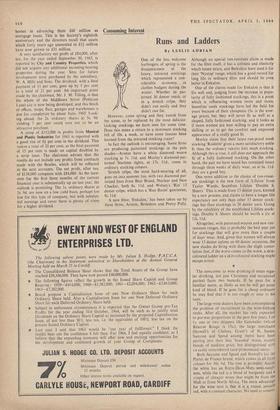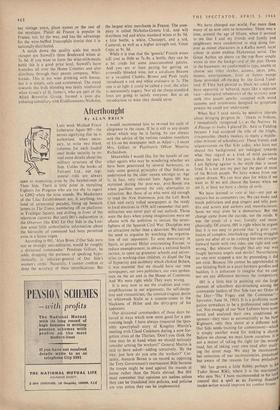Consuming Interest
Runs and Ladders
By LESLIE ADRIAN
ONE of the less welcome harbingers of spring is the disappearance of the heavy, textured stockings which represented a con- siderable economy in clothes budgets during the winter. Whether in pat- terned 30 denier mesh, or in a stretch crêpe, they didn't run easily and they didn't run far.
However, come spring and they vanish from the scene, to be replaced by the most delicate- looking stockings we have seen for some time. Does this mean a return to a minimum stocking bill of 10s. a week, or have some lessons been learned from the textured stocking craze?
In fact the outlook is encouraging, Some firms are producing patterned stockings in the pale shades—Aristoc have a white diamond weave stocking at 7s. I Id. and Morley's diamond-pat- terned Startime tights, at 17s. I Id., come in ordinary stocking colours.
Stretch crêpe, the most hard-wearing of all, goes on into summer too, with two diamond pat- terned lines from Bear Brand, Nuclear and New Checker, both 8s. 11d. and Wolsey's 'Rio' 15 denier crepe, which has a 'Run Resist' guarantee, 8s. 11d.
A new fibre, 'Enkalon,' has been taken up by three firms, Aristoc, Berkshire and Pretty Polly. Although no special run-resistant claim is made for the fibre itself, it has a softness and elasticity which lessen strain, and Berkshire have used it for their `Nystop' range, which has a good record for long life in ordinary fibre and should be even better in Enkalon.
One of the claims made for Enkalon is that it fits well and, judging from the increase in popu- larity of fully fashioned stockings, this is a point which is influencing women more and more. Seamfree mesh stockings have led the field for years because of their cheapness (5s. is the aver- age price), but they will never fit as well as a shaped, fully fashioned stocking, and it looks as if more women are now willing to pay an extra shilling or so to get the comfort and improved appearance of a really good fit.
Morley claim that their latest run-proof mesh stocking 'Roulette' gives a more satisfactory ankle fit than the ordinary tubular knit mesh stocking. Although this is true, it still does not approach the fit of a fully fashioned stocking. On the other hand, the pair we have tested has remained intact through three weeks of daily wear, so at 6s. l Id. they are a good buy.
One more addition to the choice of run-resist- ant stockings is the new form of 'Lifelon' from Taylor Woods, Seamfree Lifelon 'Double S. Sheers.' This is made from 15 denier yarn, knitted by a new process, and claims to have a longer life expectancy not only than other 15 denier stock- ings but than stockings in 20 denier yarn. Going by the reliability of the established Lifelon stock- ings, Double S. Sheers should be worth a try at 12s. l Id.
Altogether, with patterned weaves and new run- resistant ranges, this is probably the best year yet for stockings that will give more than a couple of days' wear. And, given that women will always wear 15 denier nylons on 60 denier occasions, the new shades do bring with them the slight conso- lation that, if the worst comes to the worst, a skin- coloured ladder on a skin-coloured stocking might escape notice.
The newcomer to wine drinking (I mean regu- lar drinking, not just Christmas and occasional parties) faces two hazards. If he pays for a familiar name, as likely as not he will get sonic kind of blend. If he goes for a cheap ordinaire he may find that it is too rough or sour to his taste.
The large wine dealers have been contemplating the problem of recruitment to the wine-bibbing ranks. After all, the market has only expanded to pre-war proportions in the past five years. Led bs one or two shippers like Geisweiler (whose Reserve Rouge is 15s.), the large merchants (Stowell's of Chelsea, Grant's of St. James, Saccone and Speed among them) have been putting into their lists 'bralided' wines, mainly blends of medium price, but distinguished with an easily remembered (and pronounced) name.
Both Saccone and Speed and Stowell's list the Plaisir de France brand, which comes in all three colours for 10s. 6d. The rosé is probably Anjou. the white has an Entre-Deux-Mers semi-sweet- ness, while the red is a blend of burgundy and a couple of cheaper wines that might be from the Midi or from North Africa. The main advantage for the wine tyro is that it is a round, smooth red, with a constant character. No need to remeiw
ber vintage years, place names or the rest of the mystique. Plaisir de France is popular in France, too, by the way, and has the advantage for the wine-baffled francophile tourist that it is nationallydistributed.
A notch down the quality scale but much cheaper are Stowell's three Boulevard wines at 7s. 6d. If you want to form the wine:with-meals habit this is a good price level. Stowell's have branches all over the Home Counties and also distribute through their parent company, Whit- breads. This is not wine drinking with finesse, but it is simple, safe and economical. The trend towards this bulk blending was lately reinforced when Grant's of St. James's, who are part of the Allied Breweries Group, formed a joint dis- tributing subsidiary with Etablissements Nicholas,
the largest wine merchants in France. The com- pany is called Nicholas-Grants Ltd., and will distribute red and white standard wines at 8s. 9d. a litre bottle, a white, Chassepre, and a red, Canteval, as well as a higher strength red, Vieux Ceps, at 9s. 3d.
While it is true that the 'generic' French wines still cost as little as 7s.-8s. a bottle, they can be a bit crude for some unaccustomed palates. And you are at least paying for getting an avowedly blended wine, not a soi-disant Beaune or a so-called Chablis. Brown and Pank lately .ntroduced a red and white ordinaire at 7s. The one is so light it could be called a rosd; the other is innocuously sugary. Not all the cheap standard lines are going to satisfy everyone. But as an introduction to wine they should serve.



































 Previous page
Previous page